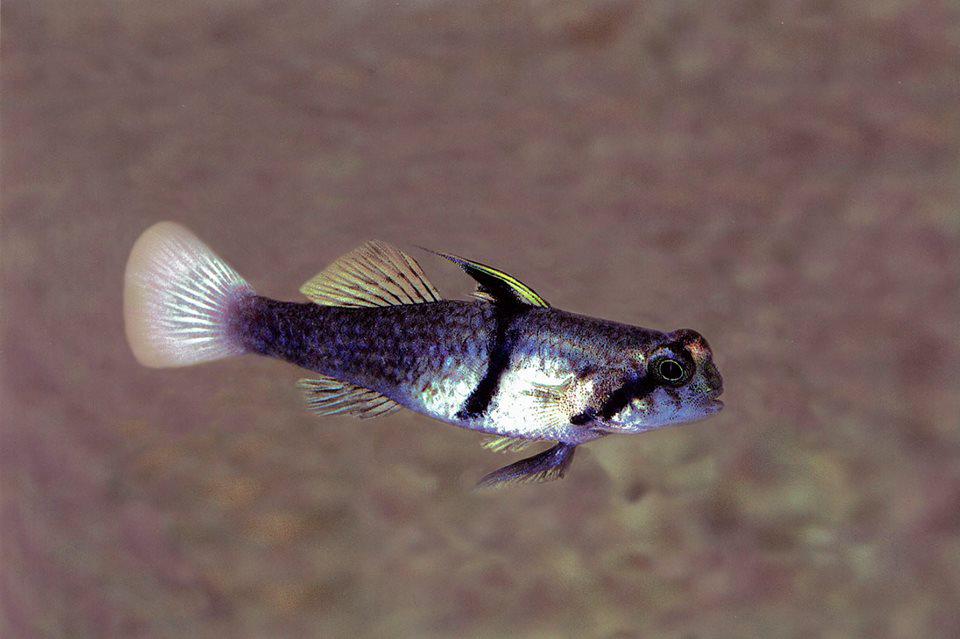Rhinohorn Goby, Redigobius balteatus (Herre 1935)

A Rhinohorn Goby, Redigobius balteatus, from Townsville. Source: Neil Armstrong. License: All rights reserved
Summary:
A pale goby with yellowish speckling or marbling, a distinct black diagonal band across the cheek to the pectoral-fin base, anterior dorsal-fin rays bright yellow to deep orange, and the rear of the first dorsal fin black continuing onto body as a broad black band.
Cite this page as:
Gomon, M.F. 2015, Redigobius balteatus in Fishes of Australia, accessed 27 Jun 2025, https://fishesofaustralia.net.au/Home/species/153
Rhinohorn Goby, Redigobius balteatus (Herre 1935)
More Info
|
Distribution |
Known in northern Australia from Wyndham, Western Australia, across the tropical north to Whitsunday Island, Queensland; occurs elsewhere in the tropical western Pacific. Inhabits brackish mangrove estuaries and the lower reaches of freshwater streams. |
|
Features |
Dorsal fin VI + 1, 6-7; Anal fin I, 6; Caudal fin (segmented rays) 17; Pectoral fin 15-18; Pelvic fin I, 5; TRB 9-11; Vertebrae 11-12 + 14-15 = 25-26. Body compressed, relatively cylindrical. Head deeper than wide, slightly broader ventrally; interorbital narrow. Anterior nostril in short tube, just behind upper lip; mouth terminal, sometimes enlarged in males. Mouth slightly oblique, of small to moderate size, rear end of jaws reaching to below front half of eyes in female and young males and well beyond eyes in large males; tongue tip blunt; gill openings narrow, reaching to just under operculum; pectoral girdle smooth, with bony to fleshy flange on anterior edge of cleithrum. Body scales mostly ctenoid, lateral series 23 25; scales mostly ctenoid on nape before first dorsal fin, ctenoid scales on operculum, cycloid on pectoral fin bases and area before ventral fins; top of head scaled forward to eyes, predorsal scales 9-12. Two dorsal fins, first dorsal with long and pointed, second and third spines elongate; second dorsal and anal fins moderate in height, pointed posteriorly; caudal fin with rounded margin. Pectoral fins oval and slender, reaching to above anal fin origin. Pelvic fins fused to form cup-shaped disc, reaching about half-way to anal fin. |
|
Size |
To around 3.8 cm. |
|
Colour |
Head and body pale with yellowish speckling or marbling, with five dark brown internal blotches along mid-ventral line from just behind anal fin origin to just before caudal fin; characteristic dense black band extending down and back from first dorsal fin, distinct black band extending from eye diagonally across opercle to lower edge of pectoral fin base; anterior part of first dorsal fin bright yellow to deep orange, black portion of fin may have iridescent blue patch in centre; eye golden to brown with black or pink spots on either side of the black bar crossing interorbital. |
|
Biology |
Likely to be oviparous, benthic spawners. |
|
Fisheries |
Popular aquarium species. Monks (2006) give details of keeping this and several other species in captivity. |
|
Species Citation |
Vaimosa balteata Herre, A.W. (1935). New fishes obtained by the Crane Pacific Expedition. Field Mus. Nat. Hist. Publ. 335 (Zool.)18(12): 383–438 figs 31–33 [419]. Majalibit Inlet, Waigeo Island, Indonesia. |
|
Author |
Gomon, M.F. 2015 |
Rhinohorn Goby, Redigobius balteatus (Herre 1935)
References
Allen, G.R., Midgley, S.H. & Allen, M. (2002). Field Guide to the Freshwater Fishes of Australia. Perth : Western Australian Museum 394 pp.
Monks, N. (ed.) 2006. Brackish-water fishes. An aquarist’s guide to identification, care and husbandry. T.F.H. Publications Ltd, Neptune City.



